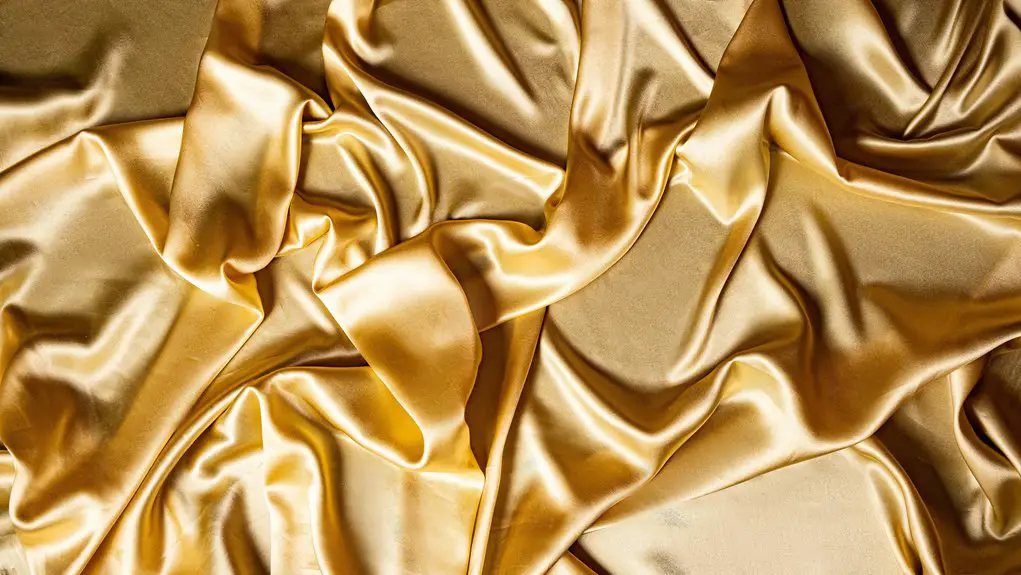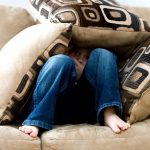IKEA Lyocell sheets are made from sustainably sourced eucalyptus fibers, crafted through an eco-friendly, closed-loop process that recycles water and chemicals to reduce waste. You’ll find them silky-soft, breathable, and gentle on your skin, with natural moisture-wicking and wrinkle resistance. These sheets offer durability and comfort while minimizing environmental impact compared to cotton. If you want to understand how this sustainable fabric is made and why it’s such a smart choice for your bedroom, keep exploring its story.
Table of Contents
Key Takeaways
- IKEA lyocell sheets are made primarily from eucalyptus wood pulp sourced from sustainably managed forests using eco-friendly closed-loop production.
- The fabric is 100% lyocell or a lyocell-cotton blend, known for breathability, softness, and a smooth, silky texture.
- Lyocell production uses less water and fewer chemicals than cotton, minimizing environmental impact and promoting sustainability.
- Sheets are naturally hypoallergenic, moisture-wicking, wrinkle-resistant, and durable, maintaining comfort and freshness over time.
- IKEA partners with suppliers following sustainable forestry and fair labor practices to ensure responsible sourcing and quality.
What Is Lyocell Fabric?
Lyocell fabric is a type of sustainable textile made from wood pulp, often sourced from eucalyptus trees.
When you choose lyocell, you’re opting for a material that’s breathable, soft, and gentle on your skin. It feels smooth and silky, similar to cotton but with a bit more sheen.
Choosing lyocell means embracing softness, breathability, and a smooth, silky feel with a subtle sheen.
Because lyocell fibers absorb moisture well, your sheets will help keep you cool and comfortable throughout the night.
You’ll also appreciate lyocell’s natural resistance to wrinkles and its durability, meaning your sheets stay fresh and crisp longer.
Plus, lyocell is biodegradable, so it’s an eco-friendly choice.
When you buy lyocell fabric, you’re supporting innovation in sustainable textiles without sacrificing comfort or style.
The Origin of Lyocell Fibers
You’ll appreciate that lyocell fibers come from sustainably sourced wood, making them an eco-friendly choice.
The production uses a closed-loop process, which recycles almost all chemicals and water. This method helps reduce environmental impact while creating soft, durable fabric.
Sustainable Wood Sources
Although sustainable materials often come with a higher price tag, IKEA sources its wood fibers responsibly to create eco-friendly Lyocell sheets.
When you buy these sheets, you’re supporting wood harvested from sustainably managed forests certified by organizations like FSC or PEFC. This means the trees are grown and harvested in ways that protect biodiversity, soil, and water quality.
IKEA also prioritizes using fast-growing tree species such as eucalyptus, which require less water and fewer pesticides, reducing environmental impact.
By choosing wood from these certified sources, IKEA guarantees the raw materials for Lyocell fibers come from forests that contribute to long-term ecological balance.
Closed-Loop Production Process
Because the production process directly affects the environmental footprint of your sheets, it’s important to understand how IKEA creates Lyocell fibers.
IKEA uses a closed-loop production system that recycles nearly all the chemicals and water involved in turning wood pulp into fabric. This means very little waste escapes into the environment, reducing pollution considerably.
The process dissolves cellulose from sustainably sourced wood, then regenerates it into fibers without harmful byproducts. Since the solvents used are non-toxic and recycled up to 99%, you get soft, durable sheets made with minimal environmental impact.
When you choose IKEA Lyocell sheets, you’re supporting a manufacturing method designed to protect natural resources while delivering quality bedding that feels good and is better for the planet.
How IKEA Sources Lyocell for Their Sheets
When you choose IKEA’s lyocell sheets, you’re supporting raw materials sourced from responsibly managed forests.
They work closely with suppliers who follow strict sustainable forestry practices to protect the environment.
Plus, their manufacturing process guarantees the fibers are processed efficiently with minimal waste.
Raw Material Origins
Since you’re interested in IKEA’s lyocell sheets, it’s worth knowing that the company sources its lyocell fibers from sustainably managed forests.
These forests primarily provide eucalyptus wood, known for its fast growth and minimal water needs. IKEA partners with suppliers who harvest this wood responsibly, ensuring the raw material is renewable and eco-friendly.
Once harvested, the wood undergoes a chemical process that transforms it into lyocell fibers while minimizing environmental impact.
This careful selection of raw material origins guarantees that you get sheets made from natural, high-quality fibers.
Sustainable Forestry Practices
Understanding the origins of the eucalyptus wood helps you see how IKEA maintains its commitment to sustainability through responsible forestry practices.
They source lyocell fibers from eucalyptus grown in carefully managed forests, ensuring minimal environmental impact. IKEA partners with suppliers who follow strict guidelines to protect biodiversity and soil health. You can trust that the wood comes from plantations certified by organizations like FSC, which promote ethical harvesting.
This approach reduces deforestation and supports reforestation efforts, aligning with IKEA’s broader sustainability goals.
Here’s what you should know about IKEA’s sustainable forestry:
- Uses FSC-certified eucalyptus plantations
- Implements controlled harvesting cycles
- Protects local wildlife habitats
- Promotes soil conservation techniques
- Supports community engagement and fair labor practices
Manufacturing and Processing
Although the journey from eucalyptus tree to soft lyocell fabric involves several complex steps, IKEA guarantees transparency and responsibility throughout the entire manufacturing process.
You’ll appreciate that IKEA partners with suppliers who use a closed-loop system, which recycles water and solvents, minimizing environmental impact.
The wood pulp undergoes careful processing to transform it into lyocell fibers without harmful chemicals.
IKEA ensures that each step—from harvesting to fiber production—meets strict environmental and social standards.
When you buy IKEA lyocell sheets, you’re supporting a process that values sustainability, worker safety, and resource efficiency.
This commitment means you can enjoy soft, breathable sheets while knowing they’re made through a cleaner, greener method.
The Lyocell Production Process Explained
When you choose Lyocell sheets, you’re opting for fabric made through a clean and efficient process. The journey begins with sustainably harvested wood pulp, mainly from eucalyptus trees.
Choosing Lyocell sheets means embracing eco-friendly comfort from sustainably sourced eucalyptus wood pulp.
This pulp dissolves in a non-toxic solvent, creating a smooth fiber solution. The fibers are then spun into threads and woven into fabric. The process recycles over 99% of the solvent, minimizing waste and pollution.
Here’s a quick look at the Lyocell production steps:
- Harvest wood pulp sustainably
- Dissolve pulp in a biodegradable solvent
- Spin solution into fine fibers
- Weave fibers into soft fabric
- Recycle solvent for reuse
This method guarantees you get comfy sheets without compromising nature.
Environmental Impact of Lyocell Compared to Cotton
Since you care about sustainability, comparing the environmental impact of Lyocell and cotton helps you make an informed choice.
Lyocell often wins because it uses less water and fewer pesticides than cotton, which relies heavily on intensive farming. The closed-loop process in Lyocell production recycles solvents, reducing pollution, while cotton farming can contribute to soil degradation and water contamination.
Plus, Lyocell fibers biodegrade more easily, minimizing landfill waste. However, keep in mind that energy consumption during Lyocell’s manufacturing can be higher, depending on the facility.
Key Features of IKEA Lyocell Sheets
You’ll want to know what makes IKEA Lyocell sheets stand out, starting with their fabric composition.
You’ll appreciate their smooth texture and softness that feel great against your skin.
Plus, understanding their durability and care will help you keep them looking fresh longer.
Fabric Composition Details
Although the fabric composition might seem like a minor detail, it plays an essential role in how IKEA Lyocell sheets feel and perform. When you choose these sheets, you’re getting a fabric blend designed for durability and breathability.
IKEA uses a high percentage of lyocell fibers, derived from sustainably sourced eucalyptus wood pulp, which contributes to the sheets’ eco-friendliness and moisture-wicking properties. Here’s what you need to know about their composition:
- Typically 100% lyocell or a lyocell-cotton blend
- Lyocell fibers created through a closed-loop process
- Free from harmful chemicals and toxins
- Lightweight yet strong fabric structure
- Naturally hypoallergenic and resistant to bacteria
This composition guarantees your sheets stay fresh and comfortable night after night.
Texture and Softness
The fabric’s blend of lyocell fibers doesn’t just support durability and breathability—it also creates a uniquely smooth texture that feels gentle against your skin.
You’ll notice how the sheets glide effortlessly, offering a cool, silky touch that enhances your comfort throughout the night. Unlike cotton, lyocell’s surface is less prone to roughness or pilling, maintaining that soft, luxurious feel even after multiple washes.
When you run your hand over these sheets, the subtle sheen and smoothness stand out, making bedtime something you’ll look forward to.
If you’re sensitive to coarse fabrics or prone to night sweats, these sheets provide a soothing, moisture-wicking softness that keeps you comfortable and cozy.
Durability and Care
Since lyocell fibers are known for their strength, IKEA’s sheets hold up well to regular use without losing their shape or softness.
You’ll find they resist pilling and maintain their smooth texture even after multiple washes. To keep them in top condition, you should follow simple care instructions.
Here’s how to care for your IKEA lyocell sheets:
- Wash in cold or warm water on a gentle cycle
- Avoid bleach or harsh detergents
- Tumble dry on low heat or air dry
- Remove promptly to reduce wrinkles
- Iron on low if needed
Breathability and Moisture-Wicking Properties
When you sleep, your body naturally releases heat and moisture, so choosing sheets that manage these factors well can transform your nights.
IKEA’s lyocell sheets excel in breathability, allowing air to circulate freely and preventing overheating. The lyocell fibers actively wick moisture away from your skin, keeping you dry and comfortable throughout the night.
This moisture-wicking ability helps reduce night sweats and creates a cool, invigorating sleeping environment. Unlike some synthetic materials, lyocell’s natural properties make it highly effective at balancing temperature and moisture.
If you tend to get warm or sweaty while you sleep, these sheets can help regulate your body climate, promoting better rest.
With IKEA lyocell sheets, you get breathable, moisture-managing bedding that supports a refreshing and comfortable sleep experience.
Durability and Care Instructions
Longevity matters when investing in quality bedding, and IKEA lyocell sheets deliver by combining strength with easy care.
You’ll appreciate how these sheets resist wear and tear, maintaining their integrity wash after wash. To keep them in top shape, follow simple care instructions that preserve their durability and softness.
Here’s how to care for your IKEA lyocell sheets:
- Machine wash in cold water on a gentle cycle
- Use mild detergent, avoid bleach and fabric softeners
- Tumble dry on low heat or hang dry to prevent shrinkage
- Iron on low heat if needed, but they generally resist wrinkles
- Avoid overloading the washing machine to reduce friction and pilling
With proper care, these sheets will last, providing consistent quality night after night.
Comfort and Texture: What to Expect
Beyond their durability, IKEA lyocell sheets also stand out for their exceptional comfort and texture. When you slip into these sheets, you’ll notice their smooth, silky feel against your skin, thanks to the natural lyocell fibers.
They’re breathable, which means you won’t overheat during the night, making them ideal for warm sleepers. The fabric has a gentle, almost cool touch that stays consistent, providing a rejuvenating sleep environment.
You’ll also appreciate how lightweight these sheets are, yet they maintain a substantial, high-quality feel. They drape nicely over your mattress without feeling stiff or rough.
In short, IKEA’s lyocell sheets combine softness with a sleek finish, offering a cozy, luxurious sleep experience that’s hard to beat.
Price Point Versus Quality Comparison
Although IKEA’s lyocell sheets come at a budget-friendly price, they don’t compromise on quality. You get durable, soft bedding without paying premium prices.
These sheets offer excellent value, balancing cost and comfort that rivals more expensive brands. When comparing price to quality, consider:
- Smooth, breathable fabric that feels luxurious
- Durable weave that withstands washing
- Eco-friendly lyocell material sourced responsibly
- Affordable price point under many competitors
- Stylish, minimalist design that suits any bedroom
You don’t have to spend a fortune to enjoy high-quality lyocell sheets.
IKEA’s option gives you softness and sustainability without breaking the bank. If you want well-made sheets that last and feel great, these deliver solid performance for the price.
Customer Reviews and Feedback on IKEA Lyocell Sheets
How do IKEA lyocell sheets hold up in real-life use? Customers often praise their softness and breathability, noting they feel cool and smooth against the skin.
You’ll find many appreciate how the sheets resist wrinkles better than traditional cotton, making them easier to maintain. However, some mention slight pilling after multiple washes, which could affect long-term durability.
If you have sensitive skin, you’ll likely enjoy the hypoallergenic properties, as several reviewers report no irritation. A few users wish the fitted sheet’s elastic were tighter for a more secure fit, but most agree the overall quality matches the affordable price.
In short, if you want comfortable, eco-friendly sheets that perform well daily, IKEA’s lyocell option tends to satisfy most buyers.
Alternatives to IKEA Lyocell Bedding
If you’re weighing different options, several alternatives to IKEA lyocell bedding offer similar comfort and eco-friendly benefits.
You might want to explore materials that balance softness, breathability, and sustainability. Here are five alternatives to evaluate:
- Organic cotton sheets: Soft, durable, and grown without harmful pesticides.
- Bamboo bedding: Naturally hypoallergenic and moisture-wicking.
- Linen sheets: Highly breathable and get softer with use.
- Tencel sheets: Made from sustainably sourced eucalyptus, offering silky smoothness.
- Hemp bedding: Eco-friendly, antimicrobial, and very strong.
Each option brings unique qualities, so think about your personal preferences, budget, and environmental impact.
Trying these can help you find bedding that suits your sleep style while supporting greener choices.
Frequently Asked Questions
Are IKEA Lyocell Sheets Hypoallergenic?
Like a gentle breeze on sensitive skin, IKEA lyocell sheets are naturally hypoallergenic. You’ll find they resist allergens and bacteria, making them a great choice if you’re prone to allergies or want a cleaner, softer sleep environment.
Do IKEA Lyocell Sheets Shrink After Washing?
You might notice slight shrinking after washing, but if you follow care instructions—washing in cold water and air drying—you’ll keep your sheets in great shape. Avoid high heat to prevent significant shrinkage or damage.
Can IKEA Lyocell Sheets Be Ironed Safely?
You can gently iron those sheets, like smoothing out ripples on a calm lake. Just use a low heat setting and avoid steam to keep the fibers safe, so your bedding stays soft and wrinkle-free.
Are There Any Color Options for IKEA Lyocell Sheets?
You’ll find IKEA lyocell sheets come in several color options, including neutral tones and soft pastels. This variety helps you pick something that matches your bedroom decor perfectly without sacrificing comfort or style.
What Is the Thread Count of IKEA Lyocell Sheets?
Like searching for the Holy Grail of comfort, you’ll find IKEA’s lyocell sheets don’t flaunt a traditional thread count. Instead, they focus on a smooth, breathable weave that feels luxuriously soft against your skin.
- What Temperature Should You Iron Lyocell? The Perfect Setting - July 14, 2025
- Is Lyocell a Hot Fabric to Wear? The Truth About Its Cooling Properties - July 14, 2025
- How to Iron Lyocell: The Ultimate Temperature and Technique Guide - July 14, 2025







